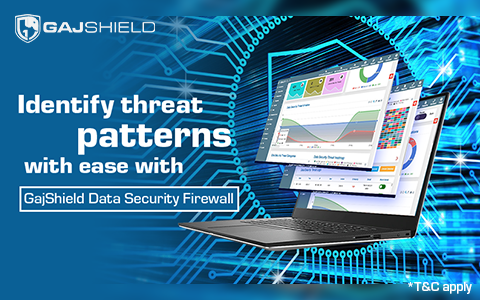Identify threat patterns with ease with GajShield Data Security Firewall
Cyberattacks can be carried out using various methods. They can come in the form of ransomware, phishing, internal data breaches, and DDoS attacks, to name a few. Enterprises need to stay ahead of their attackers now more than ever before as cyberattacks are becoming more complex and frequent. One way to ensure the highest degree of cybersecurity is by having a security heat map showing patterns that are indicative of data security threats.
Understanding security threat heatmap
A Data Security Threat Heatmap is a graphical representation of cyber risk where individual threats are represented as colored boxes. The graph is presented as a heatmap timeline that helps cybersecurity teams to easily understand and identify threat patterns as and when they emerge.
 In a nutshell, a data security threat heatmap is a simplified yet detailed representation of security threats at your enterprise.
In a nutshell, a data security threat heatmap is a simplified yet detailed representation of security threats at your enterprise.
Identifying threat patterns with data security threat heatmap
Looking at the threat heatmap, the enterprise's security team can identify threats by its recurring patterns, you can easily identify abnormalities in data security policy violations. Some of the key parameters for which you can get detailed information with Gajshield’s heatmap are:
User management: With the user management heatmap, you get the detailed information regarding users logged in to your network. Additionally, you can see continuous login attempts made by individuals and the details for login denials, such as incorrect username or password inputs. Similarly, you also have complete visibility over user activity on your network. This helps easily identify cyberattacks, prevent them, and take corrective actions against employees involved in malicious activities.
URL filtering: With URL filtering, you have visibility over employees trying to access blocked sites regularly. You can easily investigate such activities with complete URL request details such as time, employee IP address, URL requests, provided by the data security threat heatmap.
File uploads: With file uploads monitoring, you gain complete visibility over employees sharing sensitive files outside or within the enterprise without authorization. Such attempts are automatically blocked and notified to the cybersecurity team.
Emails: You have visibility regarding unauthorized emails being sent and received by employees with advanced contextual analysis such as keywords, email attachments, and suspicious links embedded in the email.
There are additional categories, other than the mentioned above. Let us also look at how such a heatmap can prevent could have helped in an actual data breach from the past.
Consider, LaunchPoint, an insurance coordination services vendor, reported a data breach in April 2017. One of its employees shared company’s sensitive data containing protected health information (PHI) including Medicare ID numbers, Medicare contract numbers, health plan ID numbers, and dates of enrollment of 18,580 customers along with included Medicare ID numbers, Medicare contract numbers, health plan ID numbers, dates of enrollment and the last names and dates of birth of 18,580 customers to his personal email address from within the organization.
How did the data breach become possible?
LaunchPoint faced a data breach because of an employee who had access to PHI and was able to send this data via email to a personal account, while the company had made considerable investments in its security system (more than $230 million) after a 2015 cyber-attack. Unfortunately, all these security improvements couldn’t help in this situation.
A Data Security Heatmap, with the data security policies in place, would have plotted the user's activity while alerting LaunchPoint’s security officials to take active measures, preventing such an incident from being executed.
The Data Security Firewall is a leap ahead of the traditional Next Last Generation firewall with Data First Approach for security. It understands organizations data, provides deeper data-level visibility and allows to control the data threat surface, taking appropriate security measures to prevent data exploitation.
Get In Touch With Us
Subscribe to our Newsletter
2025 © GajShield Infotech (I) Pvt. Ltd. All rights reserved.
